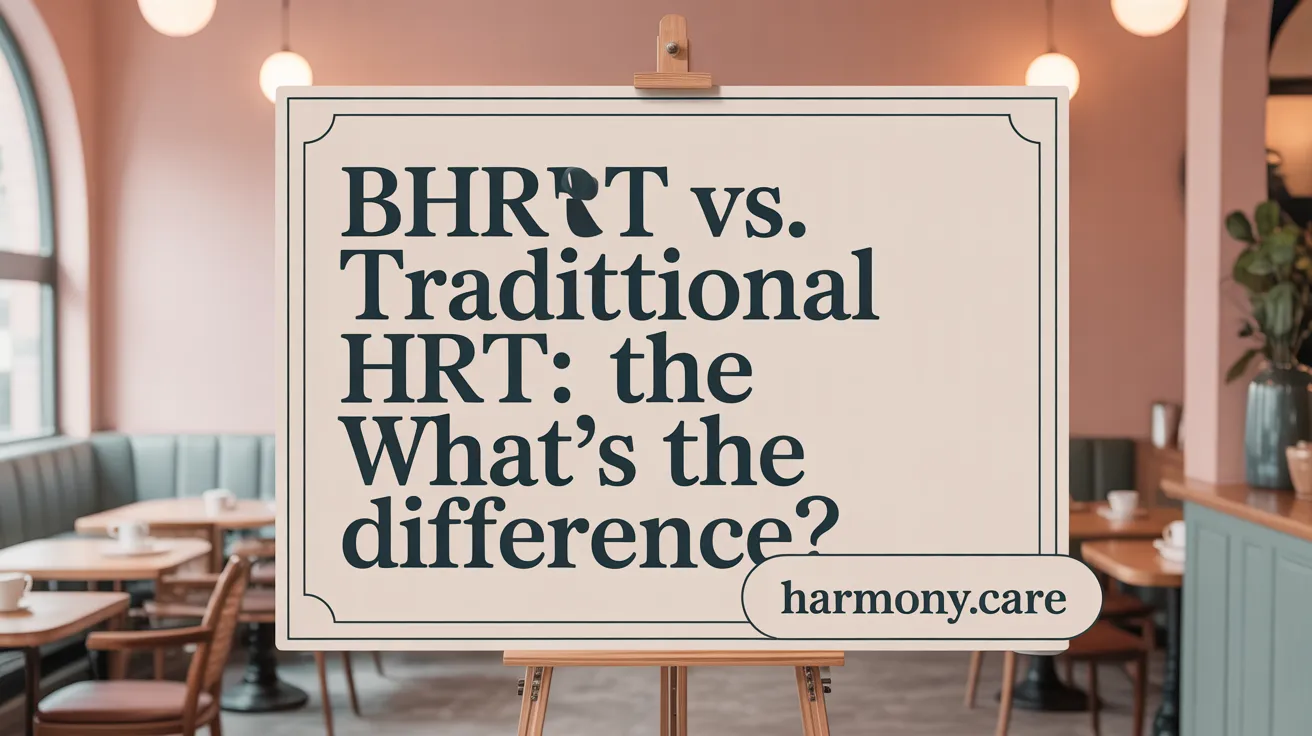Understanding Bioidentical Hormone Replacement Therapy
Bioidentical Hormone Replacement Therapy (BHRT) has emerged as a notable approach to managing hormonal imbalances associated with aging, menopause, and other health conditions. This therapy employs hormones that are chemically identical to those naturally produced by the human body, offering a personalized treatment option designed to restore hormonal balance and alleviate a range of symptoms. This article explores the fundamental principles of BHRT, its benefits, risks, and its role in improving overall well-being.
What is Bioidentical Hormone Replacement Therapy and How Does it Work?

What is bioidentical hormone replacement therapy (BHRT), and how does it work?
Bioidentical hormone replacement therapy (BHRT) uses hormones that are chemically the same as those naturally produced by your body. These hormones are typically derived from plant sources like yams, soy, or cactus, making them plant-based and designed to mimic your body's hormones exactly.
Which hormones are involved in BHRT?
The primary hormones involved in BHRT include estrogen, progesterone, and testosterone. These hormones play vital roles in regulating mood, bone health, reproductive functions, and overall energy levels. During menopause or andropause, levels of these hormones decline, leading to various symptoms such as hot flashes, fatigue, and decreased libido.
How are bioidentical hormones sourced?
Bioidentical hormones are often sourced from plants like yams and soy. They are then processed in laboratories to produce hormones that are identical at the molecular level to those your body naturally makes.
In what forms can bioidentical hormones be administered?
People can take bioidentical hormones in multiple forms, including pills, patches, creams, gels, injections, and pellets. This variety allows treatment to be tailored to individual preferences and symptom severity.
How do bioidentical hormones work at the molecular level?
Once administered, these hormones bind to specific receptors in different tissues of the body. For example, estrogen binds to estrogen receptors in reproductive tissues, helping to regulate temperature, mood, and skin health. The hormones’ molecular similarity ensures they exert effects just like natural hormones, promoting balance and symptom relief.
What is the difference between FDA-approved and compounded bioidentical hormones?
FDA-approved bioidentical hormones have undergone rigorous safety and efficacy testing and are manufactured under strict regulations. They are often available by prescription and come in standard doses. In contrast, compounded bioidentical hormones are custom-mixed by pharmacies based on individual prescriptions. These are not FDA-approved, and their safety, quality, and consistency are not guaranteed, posing potential risks. Healthcare providers generally prefer FDA-approved options due to their tested safety profiles.
Health Benefits of Bioidentical Hormone Replacement Therapy

What are the health benefits of bioidentical hormone replacement therapy?
Bioidentical hormone replacement therapy (BHRT) provides numerous health advantages by restoring hormones at a molecular level to mirror those naturally produced by the body. One of its primary uses is to ease symptoms associated with menopause and andropause, including hot flashes, night sweats, vaginal dryness, mood swings, decreased libido, sleep issues, fatigue, weight gain, and memory problems.
In addition to symptom relief, BHRT can play a significant role in strengthening bones and preventing osteoporosis. By promoting bone formation and reducing bone loss, it helps maintain bone density and reduces fracture risk. Moreover, it can enhance the elasticity and appearance of skin, making it more hydrated, reducing wrinkles, and supporting overall skin health.
Sexual wellness is another area benefit, with many users reporting improved libido, better sexual comfort, and increased satisfaction. Energy levels often increase, while mood stabilizes and sleep quality improves, contributing to overall better quality of life.
Research suggests that BHRT may help lower the risks of serious diseases such as Alzheimer’s, heart disease, and certain types of stroke, although more studies are needed to confirm these potential benefits.
Compared to traditional hormone therapies, bioidentical hormones, especially those approved by the FDA, are considered safer with fewer side effects. However, it’s crucial to differentiate between FDA-approved bioidentical hormones and compounded formulations, which are not approved and may present additional risks. Overall, BHRT offers a comprehensive approach to managing menopausal and aging-related health concerns, supporting longevity and well-being.
Comparing Bioidentical Hormone Therapy with Traditional Hormone Therapy
 Bioidentical hormone therapy (BHRT) differs from traditional hormone therapy (HRT) mainly in the source and chemical structure of the hormones used. BHRT involves hormones that are chemically identical to those produced naturally by the human body, usually derived from plant sources like yams and soy. Traditional HRT, on the other hand, often uses synthetic hormones or those derived from animals, such as pregnant horse urine.
Bioidentical hormone therapy (BHRT) differs from traditional hormone therapy (HRT) mainly in the source and chemical structure of the hormones used. BHRT involves hormones that are chemically identical to those produced naturally by the human body, usually derived from plant sources like yams and soy. Traditional HRT, on the other hand, often uses synthetic hormones or those derived from animals, such as pregnant horse urine.
In terms of effectiveness, both therapies aim to reduce menopausal symptoms such as hot flashes, night sweats, vaginal dryness, and mood swings. Some research suggests that bioidentical hormones may lead to fewer side effects; however, there is no conclusive evidence that they are more effective at symptom relief than conventional HRT. Moreover, many benefits attributed to BHRT, especially those marketed as 'natural,' are not supported by scientific studies.
Safety profiles and regulatory controls vary significantly between the two. FDA-approved bioidentical hormones are tested for safety and efficacy, ensuring quality and consistent dosing. Conversely, compounded bioidentical hormones—custom-mixed in pharmacies—are not regulated by the FDA, carrying potential risks due to variability in strength, purity, and quality. This lack of oversight raises concerns about safety and actual content.
Clinical studies have shown that compounded bioidentical hormones do not offer clear advantages over traditional medications and may sometimes carry increased risks, especially if not prepared properly. Side effects from both types of therapy can include weight gain, headaches, mood swings, and breast tenderness. Notably, both therapies can increase the risk of blood clots, stroke, and possibly breast cancer, particularly with long-term use.
Professional organizations such as the American College of Obstetricians and Gynecologists recommend caution regarding compounded BHRT due to insufficient evidence of safety and benefits. Standardized, FDA-approved hormone treatments are generally preferred, as they are backed by thorough testing and regulatory oversight.
In summary, while bioidentical hormones are chemically identical to natural hormones and may offer some cosmetic or health benefits, current evidence does not establish their superiority or enhanced safety over traditional hormone therapy. Choices should be made under professional guidance, considering individual health risks and needs.
| Aspect | Bioidentical Hormone Therapy | Traditional HRT | Regulation and Source | Effectiveness | Side Effects & Risks |
|---|---|---|---|---|---|
| Composition | Chemically identical to natural hormones, often plant-derived | Synthetic or animal-derived hormones | FDA-approved (regulated) vs. compounded (unregulated) | Symptom relief comparable; no clear superiority | Similar side effects; possible increased risks, especially with long-term use |
| Safety & Regulation | FDA-approved formulations are tested; compounded are not | Well-regulated | Variability in compounded forms; safety not guaranteed | Both effective but with caution advised | Blood clots, stroke, cancer risks; compounded higher uncertainty |
| Recommendation | Use FDA-approved when possible; professional consultation recommended | Standard treatment option | Professional guidelines favor regulated options | Depend on individual needs | Always evaluate individual risks and benefits |
Overall, the decision to use bioidentical versus traditional hormone therapy should involve a comprehensive discussion with a healthcare provider, taking into account personal health history, preferences, and the current scientific evidence.
Safety, Risks, and Side Effects of Bioidentical Hormone Replacement Therapy

Is bioidentical hormone replacement therapy safe, and what are the potential risks?
Bioidentical hormone replacement therapy (BHRT) is generally regarded as safe when it is carefully prescribed and monitored by healthcare providers, particularly in its FDA-approved forms derived from natural plant sources such as estradiol and micronized progesterone. These formulations are tested for safety, quality, and dosage accuracy, offering a level of assurance about their use.
However, compounded bioidentical hormones—custom-mixed in pharmacies without FDA oversight—may pose additional risks. Because these do not undergo strict testing, concerns include potential contamination, inconsistent potency, and unpredictable effects.
The risks associated with BHRT include increased chances of blood clots, stroke, and gallbladder disease. There is also concern about elevated risks of hormone-sensitive cancers, such as breast and endometrial cancer, especially when used over long periods or at higher doses. The individual’s age, health background, and duration of hormone therapy influence these risks.
Though some studies suggest that bioidentical hormones may be safer than traditional synthetic options, they are not entirely without danger. All hormone therapies carry inherent risks, making personalized medical evaluation crucial.
Monitoring and regular health assessments help ensure that treatment benefits outweigh potential harm. Adjusting dosage, choosing appropriate delivery routes—such as skin patches or vaginal creams—and limiting treatment duration are strategies to minimize adverse effects.
In conclusion, while BHRT offers symptom relief and potential health benefits, it requires careful individual assessment and ongoing medical oversight to maximize safety and efficacy.
Search query: Safety and Risks of Bioidentical Hormone Replacement Therapy
Personalization and Suitability of BHRT for Individual Needs
 How is bioidentical hormone replacement therapy personalized to suit individual needs?
How is bioidentical hormone replacement therapy personalized to suit individual needs?
Bioidentical hormone replacement therapy (BHRT) is highly tailored to each person’s unique hormonal profile. Healthcare providers typically start by assessing hormone levels through comprehensive blood or saliva tests. These tests help identify specific deficiencies or imbalances in hormones such as estrogen, progesterone, or testosterone.
Based on these assessments, providers customize hormone formulations and dosages to meet individual needs. For example, a woman experiencing hot flashes and vaginal dryness may require different hormonal support than someone mainly concerned with mood changes or sleep issues. This personalized approach ensures that treatment targets specific symptoms and addresses the root causes of imbalance.
Delivery methods are also chosen to suit personal preferences and tolerances. Common options include topical creams, gels, or oils, especially for those who prefer avoiding oral medications. Compounded hormones allow precise adjustments in dose, giving flexibility to fine-tune therapy over time.
Monitoring is an essential part of BHRT. Regular follow-ups involve checking symptom improvements and sometimes repeating hormone tests. Adjustments are made accordingly, ensuring safety and optimal results.
The role of healthcare professionals is critical. They guide the entire process—from initial assessment to ongoing management—helping manage potential side effects, prevent complications, and optimize the therapy plan.
In terms of target populations, BHRT is especially suitable for perimenopausal and menopausal women. It can also benefit men experiencing low testosterone levels that affect energy, muscle mass, and sexual function. This personalized care strategy aims to improve overall quality of life by restoring hormonal balance tailored specifically to each individual’s needs.
BHRT’s Role in Aging, Menopause Management, and Skin Health
What role does bioidentical hormone replacement therapy play in managing aging and menopause symptoms?
Bioidentical hormone replacement therapy (BHRT) is widely used to manage symptoms associated with aging and menopause by restoring hormone levels similar to those produced naturally by the body. Derived from plants such as yams and soy, these hormones mimic the body's own, providing relief from hot flashes, night sweats, vaginal dryness, mood swings, and decreased libido. Beyond easing these bothersome symptoms, BHRT offers broader health benefits like boosting bone density and supporting cardiovascular health, which tend to decline with age. Its personalized approach, through various delivery methods such as creams, pills, or pellets, helps maintain hormonal balance tailored to individual needs. Many consider BHRT as a natural alternative to synthetic hormones, helping women and men preserve vitality, mental function, and overall well-being during the aging process.
How does bioidentical hormone replacement therapy affect skin health?
One of the notable benefits of BHRT is its positive impact on skin aging. Estrogen, a primary hormone supplemented in BHRT, stimulates the production of collagen and elastin foods, which are crucial for skin firmness and elasticity. As estrogen levels decrease with age, skin can become thinner, less hydrated, and more prone to wrinkles. BHRT helps restore these hormone levels, promoting collagen synthesis, improving skin thickness, and maintaining proper hydration.
As a result, individuals often notice enhanced skin tone, increased elasticity, and a reduction in fine lines and wrinkles. This rejuvenating effect slows down visible signs of aging, giving the skin a smoother, more youthful appearance. In addition, BHRT supports skin hydration and resilience, contributing to a more vibrant, glowing complexion. Overall, by balancing hormones, BHRT plays a significant role in maintaining skin health and youthful appearance during aging.
| Aspect | Effect of BHRT | Additional Details |
|---|---|---|
| Relief of menopausal symptoms | Alleviates hot flashes, vaginal dryness, mood swings | Customizable by various delivery methods |
| Bone density benefits | Supports bone strength, reduces osteoporosis risk | Especially important post-menopause |
| Cardiovascular health | Promotes heart health, reduces cardiovascular risks | May involve estrogen supplementation |
| Cognitive and mood effects | Enhances memory, reduces depression, improves mood | Personalized hormone balancing |
| Skin health improvements | Improves elasticity, hydration, and reduces wrinkles | Stimulates collagen and elastin production |
| Muscle mass and vitality | Maintains or enhances muscle strength, energy levels | Counteracts age-related muscle loss |
In summary, BHRT offers a comprehensive approach that helps reduce aging effects and relieves menopausal symptoms. It supports vital functions such as skin elasticity, bone density, and cardiovascular health, which decline with age. Its ability to improve physical, mental, and skin health makes it an appealing option for those seeking a natural means to maintain vitality and youthful appearance.
Summing Up the Promise and Considerations of BHRT
Bioidentical Hormone Replacement Therapy represents a promising option for individuals seeking relief from hormonal imbalances linked to menopause, aging, and other health concerns. Its use of hormones identical to those produced by the human body offers a natural approach to restoring balance and enhancing quality of life. While BHRT presents numerous benefits, including symptom relief, improved bone and skin health, and enhanced vitality, safety considerations—especially regarding compounded hormones—necessitate careful medical supervision. Informed personalization and adherence to professional guidelines ensure that BHRT can be a safe and effective part of a comprehensive health strategy. Ultimately, collaborating closely with healthcare providers allows individuals to make well-rounded decisions that align with their unique health profiles and wellness goals.
References
- Bioidentical Hormones: Therapy, Uses, Safety & Side Effects
- Bioidentical hormones: Are they safer?
- Hormone Replacement Therapy - StatPearls
- Menopause Topics: Hormone Therapy
- The role of bioidentical hormone replacement therapy in ...
- 5 Benefits of Bioidentical Hormone Replacement Therapy
- BHRT vs HRT: Why Choose Bioidentical Hormone ...
